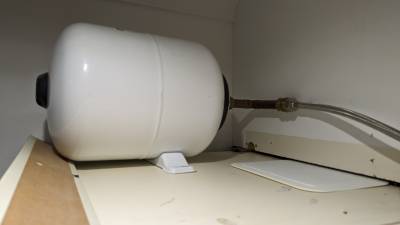Zilmet 110 ultra pro 18 (type 19) expansion vessel - Horizontal installation
This has been installed horizontally on top of a kitchen cabinet which houses the hot water tank. At the time of install I challenged the plumber on the orientation and he said that these types can be horizontal and all is fine.
I have looked on the Zilmet website and their documentation states:
"Expansion vessels should always be installed in a vertical orientation with the water
connection at the bottom.
Our requirements are simply that the vessel be installed in a way that allows future access,
and ideally be in the coolest available part of the system to assist with longevity of the
membrane. At no time can a vertical vessel be mounted horizontally, or be mounted to a
wall or framework suspended by itʼs legs."
Now, the exact model number 1100001955 is not listed in the manual and they do have "vertical and Horizontal" models. But to me this one looks like it should be Vertical as it has a wall brace.
Anyone else have this installed or experience of these?
I have sent an email to the manufacturer to confirm, hopefully i get an official reply.
Posted by: @saf1973the exact model number 1100001955 is not listed in the manual and they do have "vertical and Horizontal" models. But to me this one looks like it should be Vertical as it has a wall brace.
Anyone else have this installed or experience of these?
Thanks for including a photo @saf1973
I have five expansion vessels of differing sizes and orientations.
But it has much to do with me having a well and no mains water supply! 😎
All of these are self-installed, and I've had to replace one due to a failed membrane.
Three are for potable (treated) water, and the others for expansion in heating circuits.
The good news is that I therefore have the experience you're looking for!
The quote from the Zilmet site "Expansion vessels should always be installed in a vertical orientation with the water connection at the bottom" needs context.
It is not always the case.
Domestic well-pumps are often supplied with a horizontal expansion vessel beneath them - for which Zilmet is one of the manufacturers!
Nor is a welded bracket an indication of the preferred orientation.
Different models of expansion vessel are required depending on the 'type of water' in the system they are connected to.
Potable water, suitable for drinking, is usually connected to a vessel painted blue if it is made with cast mild steel.
But it can be left unpainted if stainless steel is chosen.
If the fluid contains system inhibitor chemicals, such as that which runs through radiators, then the vessel manufacturer may recommend that the internal rubber diaphragm is evenly in contact with that fluid.
That would occur in a vertical orientation such as you describe.
Each vessel is different, which is why it's important to select the correct one for the application.
Over time (years) there will be 'leakage' of air across the membrane.
That which enters a heating circuit will be eradicated through the air-release valves.
But the slow migration of air (gas) molecules will reduce the pressure in the expansion vessel.
This pressure is restored by using a car foot-pump to add air through the schrader valve beneath the black cap at the opposite end to the water connection.
It's tricky to do that whilst squeezing yourself into a kitchen cupboard!
Moreover, to obtain the required pressure, it's usual to have a shut-off valve on the water connection.
Otherwise you're pushing the foot-pump against the entire water circuit!
In tight situations I have two shut-off valves on the flexible connection to the expansion vessel.
By shutting both, I can remove the entire vessel from the circuit, whether it has any pressurised water inside it or not.
I can then take it outside and re-pressurise it with ease.
In most cases a pressure vessel should be oscillating around the half-full position.
If it's completely full of water then the pre-pressurised air part of the vessel needs pumping up.
You can deduce this by placing the vessel on a set of bathroom weighing scales.
1 litre of water has a mass of 1Kg.
Does that help?
Save energy... recycle electrons!
@transparent thanks for the post!
Mine is connected to the combination valve which sipplies the cold feed to the DHW tank and balanced cold to the house, so from your post it would see that it does not matter it's orientation so much? Also, this is a white vessel so is it the wrong type?
I am thinking that if it is on its side any sediment would build up under the membrane and potentially rub against it with the friction eventually bursting it. If it is vertical the sediment would remain at the bottom of the vessel and not touch the membrane. Fortunately I do have a whole house filter so sediment should be minimal.
I had a similar unit in my previous property where I maintained it, i had to release the water pressure in the system to be able to pump up the diaphram. In one instance i replaced it as the diaphram had burst. It was wall mounted but i cannot remember if that was for Potable water or the heating system.
i've just found this good YT video that explains a lot and shows a vessel in horizonal orientation...
Posted by: @saf1973... from your post it would see that it does not matter it's orientation so much? Also, this is a white vessel so is it the wrong type?
I don't think you can deduce that much from what I've said!
Zilmet will specify the orientation for each design which they offer.
It depends on a number of factors, including the composition of the butyl-rubber membrane, and the type of lacquer which may have been applied to the internal walls.
There are more combinations of features than can possibly be described by the colour which is used to paint the outside.
It is no longer the case that all manufacturers use blue to identify suitability for potable water.
As that YT video demonstrates, the new vessel chosen by the presenter is coloured white, but he introduces it as suitable for potable water!
I too have had difficulty finding the Zilmet specification sheet for your particular vessel.
However Advanced Water's site does have a document you can download which allows you to calculate the pre-charge pressure and the required total capacity you need.
Save energy... recycle electrons!
- 26 Forums
- 2,418 Topics
- 54.8 K Posts
- 404 Online
- 6,098 Members
Join Us!
Worth Watching
Latest Posts
-
RE: Ecodan Pump Issues… Circulation pump turns off when heat pump compressor turns off
@patch321 1. Why do the circulation pumps turn off...
By F1p , 16 seconds ago
-
RE: Ideal HP290 14kW ASHP - how to optimise
Roughly this should cost you £250-£300 per peak month a...
By ASHP-BOBBA , 6 minutes ago
-
RE: Installer Fitted 9kW Instead of 11kW Heat Pump and Changed MCS Paperwork - What do I do?
@jamespa thank you again. I know using the offset to tr...
By MairiA , 55 minutes ago
-

RE: Recommended home battery inverters + regulatory matters - help requested
Here's that section of the Installation Manual: &nb...
By Transparent , 3 hours ago
-
RE: New Daikin 11kW Altherma 3M install - is it working as it should?
@toodles Thank you for your input. As the days have got...
By Synthbuilder , 4 hours ago
-
RE: Advice for a novice on Mitsubishi Ecodan 6kW
Frost Protect/Freeze Stat is an operation mode, where D...
By F1p , 4 hours ago
-
RE: Fan unit Making terrible noise HELP!!
@gutoffowc Oh no, sorry to hear that, are you in the Ke...
By ASHP-BOBBA , 6 hours ago
-

RE: Sunsynk Whole House Backup Issue
@sheriff-fatman - could you please re-post that in the ...
By Transparent , 6 hours ago
-
RE: Running my new Nibe ASHP efficiently
I didn't. I spent a while manually messing around with ...
By jamieheatpumpnew , 8 hours ago
-
RE: I’m glad the cold spell is over!
I comparison with the 65kWh used above yesterday was on...
By Judith , 8 hours ago
-
RE: Octopus Cosy 12 Heat Pump Regret: Incredibly Loud, Poor Heating & Constant Hum - Help!
I should think so, I thought that pretty much universal...
By JamesPa , 9 hours ago
-

RE: Setback savings - fact or fiction?
I'm also inclined to look into how a defrost is actuall...
By cathodeRay , 9 hours ago
-
MLCP (Multi-Layer Composite Pipe) for ASHP
@editor nope. The info you reported was sufficient for ...
By iotum , 20 hours ago
-
RE: Experience - New Build / Complete New Heating System
@vincro I would be surprised if it is much above 5 to 6...
By ASHP-BOBBA , 21 hours ago
-
RE: Post-Traumatic Heat Pump Stress Disorder
Yes bang on and maybe I can illustrate that by way of e...
By iotum , 23 hours ago
-
-

RE: Replacing my 18 month old Hitachi Yutaki ASHP
A big thank you to @jamespa for all his efforts online ...
By trebor12345 , 1 day ago
-

RE: GSHP WOES! Midland based engineer recommendations?
@editor It is indeed for servicing. My current service ...
By Morgan , 1 day ago





